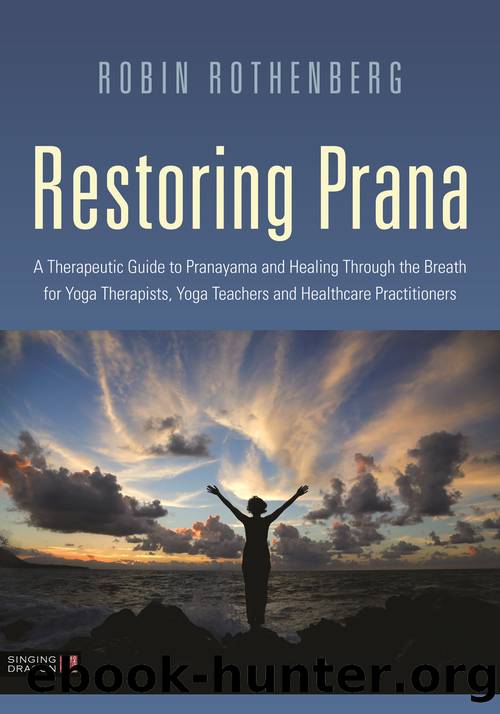Restoring Prana by Robin L. Rothenberg

Author:Robin L. Rothenberg
Language: eng
Format: epub
ISBN: 9780857013576
Publisher: Jessica Kingsley Publishers
Published: 2019-11-10T16:00:00+00:00
Photo 76
Photo 77
Photo 78
Photo 79
COUNTER POSE FOR MASTHEAD: UTTANĀSANA (STANDING FORWARD FOLD) WITH PASSING NOTES AND RAPUNZEL UNDULATIONS
NECK CORE LIFTS (PHOTOS 80 AND 81 CORRECT, PHOTOS 82 AND 83 INCORRECT)
This exercise is useful for identifying the weak links of the neck core and working isometrically to strengthen it. The key is to vertically lift rather than flex the neck, and to honor the potency of the micro-movement and slow engagement of the muscles. The lift is tiny, a hair’s breath away from the floor.
• Lay supine as for Core Breathing.
• A block between the thighs will help to maintain engagement of the abdominal core.
• Extend the index and middle fingers of both hands, curling the thumb, ring finger, and pinky into the palm.
• Place the tips of the index and middle fingers on either side of the very base of the skull (C1).
• The elbows rest on the floor or on blankets for comfort.
• Exhale and draw the chin in to JB and lift the head slightly—maybe half an inch (1 cm) off the floor at the exact spot the fingertips are cuing.
• Hold for 1–2 seconds.
• Inhale and relax down. Repeat at that same position 1–2 more times.
Note: The hands do not assist in the lift; the neck core is entirely responsible for the action. The neck does not flex. This is a straight vertical lift, with JB intact.
• Begin to work your fingertips down from C1 to C2 and repeat the process.
Most people find that as the point of the lift moves further away from the occiput (away from the base of the skull and towards the base of the neck), the action becomes more tiring and difficult to engage. It may take a number of weeks of regular practice before one can move much beyond C2 or C3. Build slowly until you are able to lift and hold comfortably through C7. Always stop and rest (and undulate) when you are fatigued.
Signs of compensation:
• Hyperextension of the neck, inability to sustain the JB action with the chin tuck.
• The arms or hands are holding the weight of the head.
• The neck flexes in and the head lifts higher than half an inch (1 cm). This indicates recruitment of other muscles, not just the neck core.
Download
This site does not store any files on its server. We only index and link to content provided by other sites. Please contact the content providers to delete copyright contents if any and email us, we'll remove relevant links or contents immediately.
Bodyweight Strength Training by Jay Cardiello(7184)
Tools of Titans by Timothy Ferriss(6945)
Born to Run: by Christopher McDougall(6259)
Inner Engineering: A Yogi's Guide to Joy by Sadhguru(5894)
Asking the Right Questions: A Guide to Critical Thinking by M. Neil Browne & Stuart M. Keeley(4574)
The Fat Loss Plan by Joe Wicks(4237)
Bodyweight Strength Training Anatomy by Bret Contreras(4058)
Yoga Anatomy by Kaminoff Leslie(3701)
Science and Development of Muscle Hypertrophy by Brad Schoenfeld(3577)
Dynamic Alignment Through Imagery by Eric Franklin(3488)
The Four-Pack Revolution by Chael Sonnen & Ryan Parsons(3484)
ACSM's Complete Guide to Fitness & Health by ACSM(3467)
Yoga Anatomy by Leslie Kaminoff & Amy Matthews(3394)
Bodyweight Strength Training: 12 Weeks to Build Muscle and Burn Fat by Jay Cardiello(3350)
The Ultimate Bodybuilding Cookbook by Kendall Lou Schmidt(3317)
Exercise Technique Manual for Resistance Training by National Strength & Conditioning Association(3291)
Nutrition for Sport, Exercise, and Health by Spano Marie & Kruskall Laura & Thomas D. Travis(3234)
Nutrition for Sport, Exercise, and Health by Marie Spano & Laura Kruskall & D. Travis Thomas(3232)
Yoga Therapy by Mark Stephens(3222)
